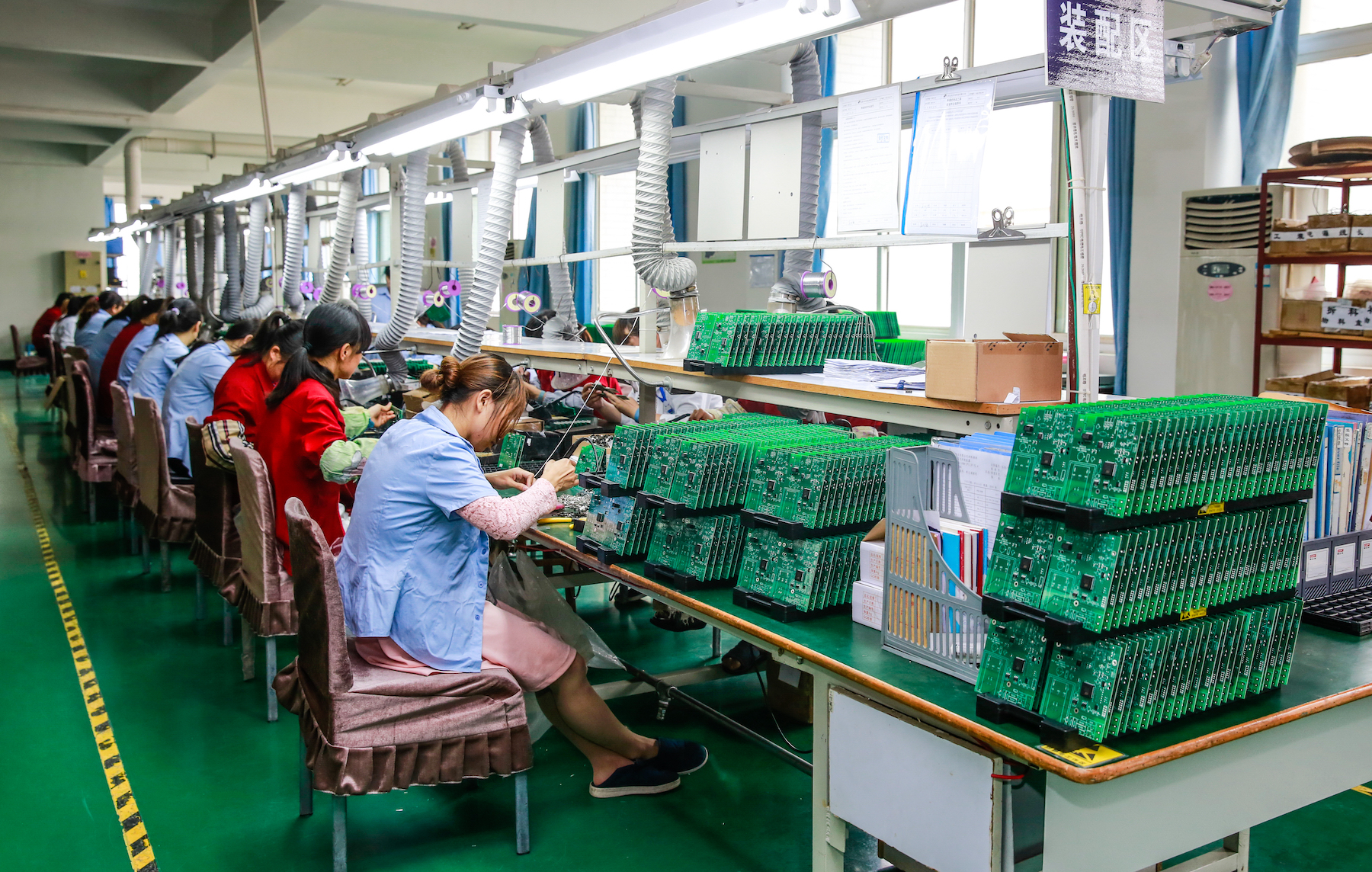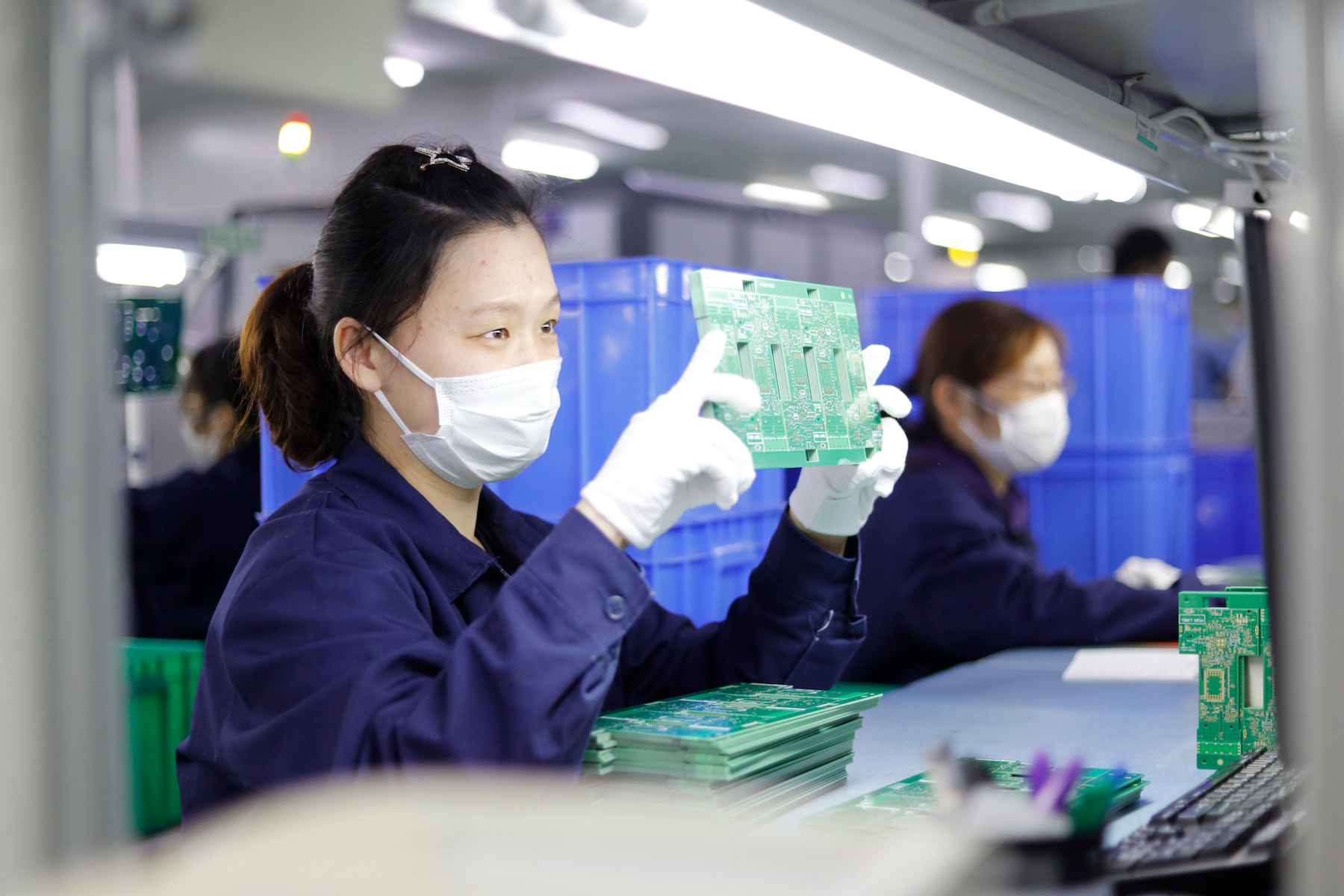- About 150 workers at Welfare Electronic Technology (运丰) in Shenzhen went on strike in April 2023, protesting relocation to a factory 200km away;
- While workers were still striking on the rooftop, China Labour Bulletin spoke to Mr. Lan, the factory's enterprise union chair, who told us that workers had negotiated with management for a portion of the compensation owed to them under China’s labour laws for factory relocation. But management called the move an “industrial upgrade,” and the local union refused to get involved;
- CLB also called the Bao’an district trade union’s psychological support department to urge for better crisis response when workers are pushed to their limits.
On 24 April, workers at a circuit board factory in Shenzhen, Guangdong province, posted videos online of over a hundred workers on strike and dozens on the factory rooftop threatening to jump if they are not compensated for being transferred to a sister factory 200 kilometres away. The parent company states that it produces for major brands including Sony, Clarion, Foxconn, Flex, NEC, and Casio.
Workers’ videos preserved in CLB’s Strike Map show the fire department responding to the workers on the rooftop of the three-storey building by placing a giant inflatable device on the ground below.
The strike lasted for at least seven days at Welfare Electronic Technology (Shenzhen) Co. Ltd. (运丰). The Shenzhen factory is owned by Welfare Printed Circuits Board Co. Ltd. in Hong Kong. The parent company opened the Shenzhen factory in 1991, and a second factory in Kaiping, Guangdong province, in 2013.

Photograph: humphery / Shutterstock.com
Since July 2022, the Shenzhen factory has been phasing out some production and moving workers to the Kaiping factory. Workers said online that they have gone on strike three other times since last summer over the relocation and lack of compensation. Workers have also periodically stationed themselves outside the factory to physically prevent equipment transfer.
According to the enterprise union, the Shenzhen factory currently employs about 300 workers, 150 of whom participated in the strike action in April. Comments on the online videos state that about one-third of the workers have already resigned within the past year, when the company began a gradual relocation process.
On 8 May, the factory posted a notice, preserved in our Strike Map, stating that since 22 April, workers had “slowed production for many days” - referring to the strike - and that to restore production, a penalty system would be put in place. Workers deemed absent a set number of days would be considered to have voluntarily resigned.
Understanding workers’ demands and their rights under the labour laws
Welfare Electronic Technology has an enterprise union affiliated with China’s official trade union. China Labour Bulletin contacted the enterprise union chair, Mr. Lan, by telephone on 28 April to understand the situation. Mr. Lan explained that negotiations fell through, despite government stakeholders being involved.
Lan: The union, the union’s lawyers, the labour department, and the local party secretary all arrived and set up a negotiation, but so far a consensus has not been reached.
CLB: Did the union negotiate on behalf of the workers?
Lan: In the negotiation, the boss offered 30 percent off, but workers want 20 percent off, so they are not satisfied.
CLB: What do you mean by 30 percent off?
Lan: The workers are only asking for 80 percent [20 percent off] of the compensation under the labour law.
CLB: But the law is the law. There is no bargaining. The boss can’t propose 30 percent less than the [minimum in the] law.
Lan: Well, it is not defined as a factory relocation, but “industrial restructuring.”
CLB noted that although these are business decisions of the factory, they will certainly affect workers, whose needs should be taken into account.
CLB: This may result in the consequence that some employees, or even all employees, will lose their jobs because of this.
Lan: Yes, the factory orders have decreased in the past few months, and some orders have also been sent out. This is to say that the workers receive 1-2,000 yuan a month, and this can’t meet their salary requirements.
But Mr. Lan believes that the situation at Welfare in Shenzhen is only temporary, and management is doing the right thing to offer workers to transfer to Kaiping. He pointed to the “temporary uncertainties” of the current economic situation and that this arrangement was preferable to shutting down, as other factories are doing.

Photograph: humphery / Shutterstock.com
But Mr. Lan admitted that management’s actions led to “distrust” among workers, which is why many have already resigned and why the strike has lasted so long and involves workers threatening to jump.
CLB: So how long has this been going on since the problem occurred and still hasn't been resolved?
Lan: It must have been six or seven days now.
CLB: Six or seven days? I saw the workers climbing the roof of the building, and that should be on the 24th and 25th, right?
Lan: It also happened today.
CLB: Today?
Lan: Today. On April 28th, the workers were still on the roof.
The enterprise union that Mr. Lan chairs is at the most grassroots level within the structure of the All-China Federation of Trade Unions. As the enterprise union chair, Mr. Lan displayed a decent understanding of the workers’ situation and their demands for compensation, but was not able to get involved before the strike. However, his actions to reach out to the higher-level unions in the district after the strike broke out are commendable.
The next level up is the street-level union in Songgang, which Mr. Lan told us had only sent outsourced lawyers to the scene. Mr. Lan had requested for the Songgang street-level union to send bread and water to the striking workers, but the union responded simply that they “had no plan to do so,” let alone step in to negotiate with the company on behalf of workers. As the enterprise union chair, Mr. Lan’s hands are tied up in the structural and bureaucratic constraints within the system.
Workers need psychological support when facing labour rights disputes
CLB also called the Bao’an district union’s psychological support department and spoke with Ms. Zhang about whether the union had sent counsellors to the workers threatening to jump. Ms. Zhang relayed to us that although she herself works for the district union, her job is to outsource the counselling services provided to workers, and the union makes use of crisis intervention hotlines at the national level and through Shenzhen city.
CLB suggested that the Welfare factory incident shows that the union should take further steps to provide counselling assistance to workers for their psychological needs. But Ms. Zhang defended the union’s inaction.
Zhang: What we can do now is to do a good job of publicity and intervention in the early stages, so our focus is on that part. When they really encounter a crisis, community-level entities are equipped with counsellors, and the companies will also provide related services. If they encounter a crisis situation, we will also go to the scene, but right now, the focus of the work is intervention and publicity - on prevention first - so that these workers will not go to the last resort to jump in this situation.
CLB: We understand that, of course, and we all know that the threat of jumping is a means. They don’t necessarily actually do it, but also we cannot rule out that the conflict will get out of hand. What I mean is that, as a new phenomenon, there are more and more officials, will our trade unions consider taking psychological counselling to the forefront to deal with this new situation? After all, the trade union says it is like the workers' family members, and represents workers' interests.
Ms. Zhang said that she would pass our recommendations along to her superiors.
Factory workers need representation as global brands reduce their orders and businesses try to survive
From this incident, we can see that workers have a deep distrust in their employers during these uncertain economic times. Although the enterprise union was present and requested aid from the local union structures, the local union has basically frozen the enterprise union out of the process and not allowed it to perform its role as a bridge between workers, the factory, and the broader ACFTU.
In addition, the psychological support department of the district union is a relatively new unit and not every union has such services. With the recent high incidence of factory worker strikes and protests in Guangdong province, the Bao’an district union has the opportunity to set the standard for how to respond to workers needing psychological assistance related to their labour rights claims.
International brands sourcing from China should take note of changing conditions in their supply chains, and their role in causing worker distress through decreased orders and shifting supply chain patterns that leave factories unable to provide compensation according to the law.
Further CLB reading:
